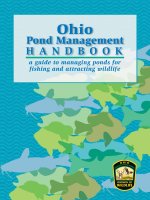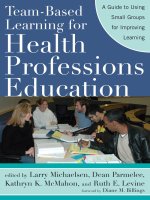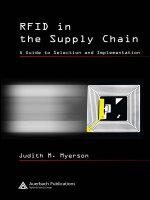Radiation threats and your safety: A guide to Preparation and REsponse for Professionals and Community pdf
Bạn đang xem bản rút gọn của tài liệu. Xem và tải ngay bản đầy đủ của tài liệu tại đây (4.89 MB, 344 trang )
Radiation threats
and your safety
A guide to Preparation and
REsponse for Professionals
and Community
Radiation threats
and your safety
A guide to Preparation and
REsponse for Professionals
and Community
Armin Ansari
Chapman & Hall/CRC
Taylor & Francis Group
6000 Broken Sound Parkway NW, Suite 300
Boca Raton, FL 33487-2742
© 2010 by Taylor and Francis Group, LLC
Chapman & Hall/CRC is an imprint of Taylor & Francis Group, an Informa business
No claim to original U.S. Government works
Printed in the United States of America on acid-free paper
10 9 8 7 6 5 4 3 2 1
International Standard Book Number: 978-1-4200-8361-3 (Hardback)
This book contains information obtained from authentic and highly regarded sources. Reasonable efforts
have been made to publish reliable data and information, but the author and publisher cannot assume
responsibility for the validity of all materials or the consequences of their use. The authors and publishers
have attempted to trace the copyright holders of all material reproduced in this publication and apologize to
copyright holders if permission to publish in this form has not been obtained. If any copyright material has
not been acknowledged please write and let us know so we may rectify in any future reprint.
Except as permitted under U.S. Copyright Law, no part of this book may be reprinted, reproduced, transmit-
ted, or utilized in any form by any electronic, mechanical, or other means, now known or hereafter invented,
including photocopying, microfilming, and recording, or in any information storage or retrieval system,
without written permission from the publishers.
For permission to photocopy or use material electronically from this work, please access www.copyright.
com ( or contact the Copyright Clearance Center, Inc. (CCC), 222 Rosewood
Drive, Danvers, MA 01923, 978-750-8400. CCC is a not-for-profit organization that provides licenses and
registration for a variety of users. For organizations that have been granted a photocopy license by the CCC,
a separate system of payment has been arranged.
Trademark Notice: Product or corporate names may be trademarks or registered trademarks, and are used
only for identification and explanation without intent to infringe.
Library of Congress Cataloging‑in‑Publication Data
Ansari, Armin.
Radiation threats and your safety : a guide to preparation and response for
professionals and community / Armin Ansari.
p. ; cm.
Includes bibliographical references and index.
ISBN 978-1-4200-8361-3 (hardcover : alk. paper)
1. Ionizing radiation Accidents. 2. Ionizing radiation Safety measures. 3.
Emergency management. I. Title.
[DNLM: 1. Radiation Injuries prevention & control. 2. Disaster Planning. 3.
Disasters. 4. Radioactive Hazard Release prevention & control. 5. Radiologic Health.
WN 650 A617r 2010]
RA569.A56 2010
362.196’9897 dc22 2009030137
Visit the Taylor & Francis Web site at
and the CRC Press Web site at
Dedication
To community members and professionals who go the extra mile
vii
CONTENTS
P ix
T A xiii
OnPart e UNDERSTANDING RADIATION
1 Introduction 3
2 Radiation in Everyday Life 7
3 Radiation 101 23
TwPart o THE IMPACT OF RADIATION
4 Accidental Radiation Emergencies 47
5 Intentional Radiation Emergencies 75
6 Health Eects of Radiation 103
7 Environmental Eects of Radiation 125
8 Psychosocial Eects of Radiation 143
rePart e RESPONDING TO RADIATION
9 Protecting Yourself and Your Family 159
10 Preparing Your Family Emergency Plan 185
11 Medical Response to Radiation Emergencies 195
12 Radiation Drugs 217
13 Government Response to Radiation Emergencies 243
14 Responding as Professionals 261
15 Responding as a Community 275
viii CONTENTS
FouPart r CONCLUSION
16 Living with the reat 291
G 293
A A: E S L 299
A B: R M
C P 303
A C: F I 309
I 315
ix
PREFACE
, of Internet shopping, I bought
an old issue of Life magazine from a shopping mall kiosk in Knoxville,
Tennessee. It was the September 15, 1961, issue and had a picture of a man
in a “civilian fallout suit” on the cover with the title “How You Can Survive
Fallout.” I browsed through the magazine thinking that it represented an era
that we had moved beyond. I had no idea that the events occurring exactly
40 years aer publication of this particular issue would launch another era
during which, once again, we would be concerned about this possibility.
Also, I had no idea at the time that I would be spending the second half
of my career working on nuclear and radiological emergency preparedness
and response issues, part of which entails lecturing and conducting training
workshops across the country. It was through these interactions with a broad
spectrum of professionals and community members that I realized that an
information gap had not been addressed, even though an enormous amount
of information was available.
ere has been an explosion of information on the subject of radiation
emergencies and related issues in the scientic and technical literature.
Multitudes of radiation textbooks ably serve professionals in their respec-
tive medical and technical elds. State, federal, and international agencies
have created numerous guidance and planning documents, and some of that
information keeps changing as new plans are drawn and new terminolo-
gies and acronyms are created. Also, numerous fact sheets and information
pages on radiation and radioactivity, radiation drugs, and other emergency
response issues can be found on governmental and nongovernmental Web
sites. Finally, an aspect of commercialism oers information to private citi-
zens as well as government consumers.
Although this vast body of information is valuable and, for the most part,
serves the intended purpose, much of it is too detailed or too technical, tai-
lored for specic audiences, or simply too dispersed. Consumers of informa-
tion who are new to the radiation arena have to si through a lot of material
to nd what is important or applicable to them. ey are likely to be over-
whelmed with information or not get enough of what they need.
My goal in writing this book is to bring together, in a concise way, essen-
tial, need-to-know, and practical information about radiation threats in an
approachable form and content. e book is written for discerning members
x PREFACE
of the general public who do not aspire to become radiation experts, but they
desire more than just a supercial knowledge of the subject; those who need
to understand the “why” so that they can use and apply the information.
Resiliency of the public at large is dependent on what they know about radia-
tion and how well they can put information and instructions from emer-
gency response and public health authorities into context.
e book is also written for professionals in various elds of expertise who
are new to the subject of radiation and who may be called upon to serve in
a radiation emergency and apply their specic knowledge and skills under
those circumstances. ese include emergency management and emergency
response professionals, hospital sta, and environmental health, mental
health, and other public health professionals. ese professionals need to
understand the radiation threat beyond what they may learn from a generic
“all hazards” or weapons of mass destruction training.
Last, but certainly not least, this book’s coverage recognizes that,
regardless of our professional backgrounds, concerns for our families’
well-being as well as our own safety will affect our response to a radia-
tion emergency, how well we do our jobs, and how we help our neighbors
and communities.
I knew that writing a book such as this for a broad audience would be
challenging. I hope that I achieved some measure of success in providing
this information in a way that is helpful for the intended audience. is book
is not intended to teach basic radiation science and theory to students of the
eld. However, it can be used in a public health or general science curricu-
lum, or portions of it can be used to develop radiation awareness training for
specic audiences. All of it is written in a suitable format for self-study.
I need to thank many individuals. Luna Han, my senior editor at Taylor
& Francis, shared the vision for this book from the beginning, guided me
in the process of preparing the proposal, and provided valuable feedback
throughout. I thank Jill Jurgensen and Judith Simon at Taylor & Francis for
their assistance in the nal editing and production process. My thanks to
Charles Miller, Robert Whitcomb, and my management at the Centers for
Disease Control and Prevention (CDC) for their support. I undertook this
task, however, in my private capacity and outside my ocial CDC duties.
erefore, I bear sole responsibility for the material in this book. Any opin-
ions expressed are mine alone (and not those of the CDC). I also have no
direct nancial interest in any product mentioned in the book.
I have beneted from collaboration and discussions with many friends and
colleagues in various organizations. I especially thank my colleagues who
took time to review various portions of the manuscript and provide valuable
comments. In particular, I am indebted to Anthony Moulton, Amy J. Guinn,
PREFACE xi
and Jerey Nemhauser, whose input certainly made this book much better
than it would have been without their generous help.
I am immensely grateful to my wife, Elham, who encouraged me con-
stantly, provided me with quiet weekends, served as my sounding board,
reviewed early dras of each chapter, chased down owners of photographs,
and, most important of all, handled the lion’s share of parenting while the
book was written. I could not have completed this work without her. I also
thank my parents, Mohammad and Anice, who instilled in me the love of
learning and showed me the importance of going the extra mile. Finally, I
thank my children, Armon and Kiana, who were so patient with their con-
stantly working dad. I hope that their generation and others to follow will
not have to be concerned with radiation threats, but instead will continue to
harness the amazing power and promise of nuclear radiation for the better-
ment of their lives.
Armin Ansari
xiii
THE AUTHOR
Armin J. Ansari is a health physicist at the Radiation Studies Branch,
Division of Environmental Hazards and Health Eects, National Center for
Environmental Health, Centers for Disease Control and Prevention (CDC)
in Atlanta, Georgia. He serves as subject matter expert in CDC’s radiation
emergency preparedness and response activities and has frequently rep-
resented the CDC on the Federal Advisory Team for Environment, Food,
and Health. Dr. Ansari chairs an interagency working group on popula-
tion monitoring in radiation emergencies and was the lead author of CDC
guidance on population monitoring for local and state public health plan-
ners. He serves on a Homeland Security Council interagency committee
for preparedness and response to radiological and nuclear threats and was
a contributing author to the federal planning guidance for response to a
nuclear detonation.
Dr. Ansari conducts training workshops and lectures extensively on the
topic of radiological/nuclear emergencies for technical and nontechnical
audiences. He was nominated for the CDC’s Charles C. Shepard Science
Award in 2006. Prior to joining the CDC, Dr. Ansari was a senior scientist
with the radiological consulting rm of Auxier & Associates in Knoxville,
Tennessee, and a project leader with the Environmental Survey and Site
Assessment Program at Oak Ridge Institute for Science and Education.
Dr. Ansari received his BS and PhD degrees in radiation biophysics from
the University of Kansas and completed his postdoctoral training at Oak
Ridge National Laboratory’s Biology Division and Los Alamos National
Laboratory’s Life Sciences Division, where he was an Alexander Hollander
Distinguished Postdoctoral Fellow. He is a diplomat of the American
Academy of Health Physics, a member of the Georgia East Metro Medical
Reserve Corps (MRC), and a member of the Gwinnett County Community
Emergency Response Team (CERT).
OnePart
UNDERSTANDING RADIATION
INTRODUCTION
in science, medicine,
energy, industry, and agriculture has brought tremendous benets
to our society. Yet, we live in a time when the threat of nuclear terrorism
and the possibility of facing a radiation emergency, including a catastrophic
nuclear detonation in one of our cities, are unfortunately very real. In the big
picture, the most eective method to deal with these threats is to keep them
from ever occurring in the rst place. Whether this goal is accomplished
through stringent safeguards and security measures for nuclear materials,
advanced surveillance and interdiction methods, engaged diplomacy, or all
of these eorts is beyond the scope of this book and the expertise of the
author. Here, we address what you should know ahead of time, what you
can do to prepare, and how you should respond to a nuclear or radiological
incident as professionals and members of our communities.
If faced with a radiation threat, regardless of where you live or what you do
for a living, everyone shares some common concerns about the immediate
safety of their families and themselves, as well as that of neighbors and co-
workers. Whether you are an emergency manager or an ambulance driver,
a school teacher or a restaurant owner, a hematologist or a surgeon, a hotel
manager or a mortician, or drive a bus or a waste collection vehicle, the way
you do your job will be aected during a radiation emergency. People also
have concerns about long-term impacts that such an incident may have on
their families’ health, their jobs, and their communities.
e underlying message in this book is that there is no reason why you
should feel helpless when faced with a radiation emergency. You can take
certain actions to protect yourself and your family. You can take actions to
help your community if it is directly aected or help a displaced population
from far away communities who have come to you for help. How we react to
a radiation emergency will determine its true nal impact.
Preparedness is a key component of resilience and the most eective
method to reduce the potential impact of such disasters. Just like any threat,
RADIATION THREATS AND YOUR SAFETY
a prerequisite for preparedness is an understanding of the nature of the
threat itself. Radiation and radioactivity invoke an immediate sense of anxi-
ety and fear in most people, largely due to lack of information. Indeed, most
people would have diculty correctly dening radiation. is inability is
not surprising, given that public perception of radiation and radioactivity, at
least for many, is formed by images of mushroom clouds, cinema and televi-
sion dramatizations, and even cartoon characters.
e need for understanding radiation is not only relevant to a radiation
emergency that may occur sometime in the future. People deal with radia-
tion issues on a continual basis. Examples include the increasing need for
alternative sources of energy, such as nuclear energy, and the dramatic
increase in use of radiation in diagnostic medical procedures over the
last two decades. Consumers need to be better informed when it comes
to using these medical services and to understanding the issues aecting
their future.
e main purpose of this book is to provide essential and practical need-
to-know information that professionals and discerning members of the
general public can use and apply in a radiation emergency as well as in
understanding and appreciating everyday radiation-related issues. Keeping
in mind this broad audience, all of whom need information they can use and
none of whom has any desire to become a radiation expert, every eort was
made so that the text
provides only information that has practical utility or is necessary •
to appreciate and understand basic concepts;
uses everyday language that is easy to follow and understand;•
avoids detailed theoretical or technical discussion unless it is abso-•
lutely necessary; and
avoids using equations to illustrate concepts—instead, explaining •
principles using words and examples.
Most chapters follow a similar structure. ey begin with an overview
section summarizing and putting in context the rest of the chapter. e
main section of each chapter has detailed discussion in plain language with
descriptions and examples as appropriate. e text is divided into multiple
headings so that readers can easily navigate throughout the chapter. As
much as an author may desire otherwise, many readers will not read the text
in sequence and they may not be interested in every topic. e many cross-
references will facilitate navigation for these readers.
Most chapters include one or more brief paragraphs starting with the
phrase, “Did you know?” ese segments are not essential information, but
rather are included to provide additional context, put information in per-
spective, or simply oer nuggets of information readers may nd interesting.
INTRODUCTION
Each chapter ends with a short, annotated list of selected resources for read-
ers who need additional, in-depth information.
Finally, it is common to use only SI units in publications.* Although most
of the world has adopted the international units of radiation in practice,
the fact remains that in the United States, federal and state government
documents, rst responder training courses and manuals, and radiation
detection instruments still use the conventional units of radiation, and the
practice is likely to continue for the foreseeable future. For this reason, con-
ventional units are listed in parentheses each time the international units
are used.
* e International System of Units (SI) (see />








![cruising the mexican riviera and baja [electronic resource] a guide to the ships and the ports of call.](https://media.store123doc.com/images/document/14/y/pc/medium_pcm1401351395.jpg)
